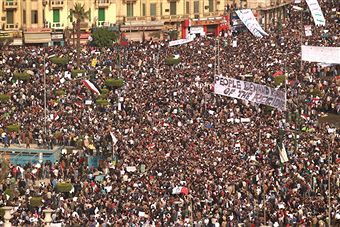 Alastair Beach is on the ground in Cairo. Here is his report for Coffee House:
Alastair Beach is on the ground in Cairo. Here is his report for Coffee House:
As the imam rounded off his midday Friday sermon, the ring of more than three hundred riot police encircled the worshippers.
It was no ordinary congregation. A stellar assortment of Egyptian directors, actors and political bigwigs were assembled in an enormous crowd on the pavement outside the Mustafa Mahmoud mosque in Mohandiseen, Western Cairo.
Over the loudspeaker, the imam drew polite applause from the listeners when he praised protestors who had turned out for the initial demonstration in Egypt’s uprising a week last Tuesday. But then he put his foot in it. “Democracy should involve free speech but without the trouble,” he intoned solemnly in Arabic. “Every protest in life has to be done with patience.” Ahmed Younis, a seventeen year-old student standing nearby, was not impressed. “We’ve been patient for the past thirty years.”
Minutes later the atmosphere had turned febrile, as the worshippers began to chant anti-government slogans. The baton-wielding riot police, who had been drafted in after the surprise turnout during Tuesday’s protest, soon crumpled under the pressure, and were forced to allow the heaving crowd out.
By the middle of this week some of the protestors, along with thousands of others, would be camping out in Tahrir Square, the iconic plaza in downtown Cairo which has become the focus of Egypt’s upheaval.
But last Friday the Egyptian capital was still tightly under the control of the authorities. The demonstrators from Mohandiseen were just one group among many across the city who had gathered before midday prayers with the intent of shattering the status quo.
By the time they had walked the few miles south-east to reach the Galaa bridge – the small crossing onto Zamalek, an upmarket residential island on the Nile – it was clear they were going to have their work cut out. Just a few yards away from the nearby Sheraton hotel, a squadron of riot-police about five men deep had completely blocked the way of the river. Four green riot vans were parked behind them.
The marchers by now must have stretched for at least a mile and a half back down the main road. As they approached the bridge, the police blasted teargas canisters into the air like mortar fire, dispersing some of the demonstrators into nearby side-alleys.
Not long afterwards at around 2 p.m., the signature chant of the anti-Moubarak movement rang out: “The people want the system to fall!” The next few hours saw something close to open warfare on the streets of Cairo, as scenes unknown during Hosni Moubarak’s time unfolded.
Officers brandishing their batons like sabres beat back charging demonstrators, and shielded themselves from a continuous hail of stones and broken masonry. After the marchers broke through across Galaa bridge, retching, red-eyed individuals lay gassed and drooling like sick infants at the side of the pavements. One man, kneeling exhausted with two rocks in his hands, cried out simply: “Freedom. My god, I want freedom.”
By 6 p.m. the pendulum was swinging against the riot police. The thousands of demonstrators from Mohandiseen had broken through into Tahrir Square and had met up with other groups from around the city. The riot police had amassed on Qasr El-Aini Street, the road running south from Tahrir towards the parliament.
A nearby mosque was appropriated as a makeshift hospital. Ahmed Ra’asat, a twenty-six year-old dentist, was one of the bloodied and bandaged protestors lying grim-faced on the floor.
“This is violence against a people,” he said, as a loudspeaker from the mosque implored people to give blood, and chants of “Leave Hosni! Leave Hosni!” rang through the air outside. “The president’s days are finished. It’s game over.”
A trip to the French Institute Hospital, a mile or so south of Tahrir Square, confirmed the ferocity of the evening’s events.
Here alone thirteen had died. All had suffered shotgun wounds from police weapons, according to Dr Ahmed Mawad, from the Intensive Care Unit. More than four hundred were wounded. At the nearby Old Qasr El-Aini Hospital, they recorded twenty dead and five hundred injured. Shotguns were again the biggest cause of death.
By the next morning the army had taken control of the streets. At least twelve tanks and twenty armoured personnel carriers were blocking off the main roads into Tahrir Square. Towering over them was the smouldering riverside HQ of the ruling National Democrat Party, which had been torched the previous night.
Over the next few days an uneasy calm settled over Cairo. Banks remain closed after the Friday demonstration, while looters emptied ATMs all round the city. The stock market also took a tumble, losing sixteen points over two days by Monday.
Nevertheless, many remained optimistic. “When the people are free, maybe they will struggle for a couple of days or months, “ said Ali Shoukri, a twenty year-old manning the barricades in the central district of Garden City. “But the results will always be good ones.”
As the violent aftershocks of Tunisia’s Jasmine Revolution shake Hosni Moubarak’s government to its foundations, there are millions of Egyptians hoping his prediction will prove to be correct.






Comments